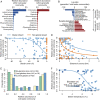Specialized meltwater biodiversity persists despite widespread deglaciation
- PMID: 32424087
- PMCID: PMC7275702
- DOI: 10.1073/pnas.2001697117
Specialized meltwater biodiversity persists despite widespread deglaciation
Abstract
Glaciers are important drivers of environmental heterogeneity and biological diversity across mountain landscapes. Worldwide, glaciers are receding rapidly due to climate change, with important consequences for biodiversity in mountain ecosystems. However, the effects of glacier loss on biodiversity have never been quantified across a mountainous region, primarily due to a lack of adequate data at large spatial and temporal scales. Here, we combine high-resolution biological and glacier change (ca. 1850-2015) datasets for Glacier National Park, USA, to test the prediction that glacier retreat reduces biodiversity in mountain ecosystems through the loss of uniquely adapted meltwater stream species. We identified a specialized cold-water invertebrate community restricted to the highest elevation streams primarily below glaciers, but also snowfields and groundwater springs. We show that this community and endemic species have unexpectedly persisted in cold, high-elevation sites, even in catchments that have not been glaciated in ∼170 y. Future projections suggest substantial declines in suitable habitat, but not necessarily loss of this community with the complete disappearance of glaciers. Our findings demonstrate that high-elevation streams fed by snow and other cold-water sources continue to serve as critical climate refugia for mountain biodiversity even after glaciers disappear.
Keywords: biodiversity; climate change; glacier loss; invertebrate communities; mountain streams.
Copyright © 2020 the Author(s). Published by PNAS.
Conflict of interest statement
The authors declare no competing interest.
Figures




References
-
- Rahbek C., et al. , Building mountain biodiversity: Geological and evolutionary processes. Science 365, 1114–1119 (2019). - PubMed
-
- Antonelli A., et al. , Geological and climatic influences on mountain biodiversity. Nat. Geosci. 11, 718–725 (2018).
-
- Immerzeel W. W., et al. , Importance and vulnerability of the world’s water towers. Nature 577, 364–369 (2020). - PubMed
-
- Bosson J.-B., Huss M., Osipova E., Disappearing world heritage glaciers as a keystone of nature conservation in a changing climate. Earths Futur. 7, 469–479 (2019).
Publication types
MeSH terms
LinkOut - more resources
Full Text Sources
Medical

